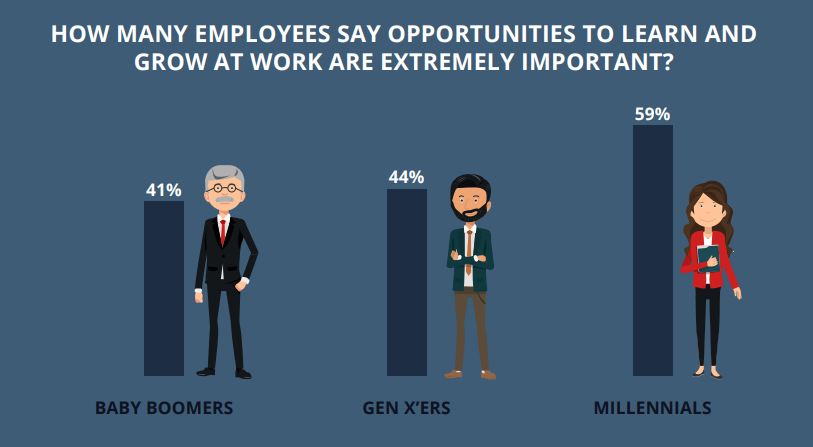Are high-performing organizations simply blessed with finding the most productive people to work for them?
The short answer is no, so we’re going to look more in-depth at the long answer – how they bypass the problems of low productivity by empowering employees to want to be more productive.
Increasing workplace productivity isn’t about telling people they have to do more. That might work short-term, but in the long run it only leads to burnout, which benefits no one. If the solution was that simple, this wouldn’t be a challenge many organizations struggle with. Growing a productive workforce is a multi-faceted issue that goes deeper than input vs. output, but it’s absolutely worth delving into.
“Not everything that counts can be counted, and not everything that can be counted counts.”
– Albert Einstein
The benefits of having a highly productive team cover an array of business results, from lower overhead and increased revenue, to faster time to market for products and higher customer satisfaction. Improving productivity is also closely tied to improving employee engagement and reducing turnover, which helps take a heavy burden off your business and catalyzes growth.
Why Aren’t People More Productive?
Employee productivity can be specifically defined a number of ways, but it’s essentially the difference in input versus output. Measuring productivity can be tricky, depending on your industry and the objectives your company is looking to achieve.
For any long-term success, your productivity metrics have to look very different when assessing machines, versus assessing people. That should sound obvious, but there are many workplaces where employees would say they feel like they’re treated the same as the machines they use.
In an article with Harvard Business Review, Dov Seidman makes this point:
“…machines will never be the source of enduring advantage. The companies that succeed best will be those that focus on the humanity of work, and capitalize on what humans can uniquely do.”
An organization that doesn’t address the human motivations behind productivity will constantly be at war with itself, fighting to grow revenue and gain advantage over the competition while continuing to lose the talented people who could make that happen.
There are a number of factors that can go into problems with low productivity:
- Company mission, vision, and values are not clear
- No connection between daily work and big picture goals
- Goals for production are unachievable, demotivating employees
- Quantity is stressed at the expense of quality
- Insufficient training with necessary tools/technology
- Technology available to use is outdated or unreliable
- Lack of career development opportunities
Varying combinations of these factors, among others, can have devastating affects for employee engagement and retention, which will directly impact every area of your organization.
The Direct Line Between Employee Productivity and Turnover
Talented, hard-working people aren’t looking for just another job, so helping them see how their work is connected to the greater mission and vision deserves an emphasis that many companies fail to communicate. If employees don’t find any fulfillment in working with their team to achieve the company’s vision, their productivity will drop. At that point, one of three things can happen:
- They’re re-inspired by leaders who communicate their individual value within the company
- They stay stagnant in the same position, never using their potential to help the company grow
- They leave the company, and turnover starts becoming a costly issue
Employee turnover hits productivity right where it hurts, causing an immediate drop in how much work can be accomplished by the team that remains. It’s more costly than many organizations realize, so preventing employee turnover can have a huge impact on the bottom line.
The Center for American Progress released a report showing that for employees earning an annual salary of $75,000 or less, the average cost of turnover was approximately 20% of their salary.
Depending on the size of your organization and your turnover rate, that can add up to hundreds of thousands of dollars – if not millions – lost annually due to employees leaving.
To get an approximate picture of your employee turnover costs (and how much you could reduce them), check out our Training ROI calculator.
How to Increase Low Employee Productivity with Training
Typically, the most obvious problems causing low productivity will be from a lack of sufficient training on software, technology, machinery, or other systems. In other words, “hard skills.” These are the kinds of skills that are apparent when something goes wrong or doesn’t get completed correctly. When someone isn’t trained properly on the most efficient way to use the systems they deal with every day, their output will suffer compared to those who know all the tricks and features of the technology available.
These kinds of hard skills can be easily addressed with training. Microlearning is a popular method of choice because of its decreased time to train, use of less resources, and higher learning retention results. An on-demand video format that covers the skills needed for the individual employee’s needs will quickly get them up to speed and more productive than before.
The skills that are often (but not always) less obvious when they are lacking are soft skills, like emotional intelligence, listening skills, problem-solving, and goal setting. Improved soft skills in any workforce has a huge effect on the company culture, which is another major factor in having lower employee turnover and higher productivity.
Soft skills are especially crucial for managers and supervisors. They play a big part in the ability to lead and coach, which are the main channels for motivating employees who aren’t seeing their value in the company or are struggling with staying productive amidst other stressors. A supervisor with high emotional intelligence and goal-setting skills will exponentially improve the motivation of their team.
It can be more difficult to measure soft skills than hard skills, but providing training in these areas is still effective through a variety of methods, including microlearning videos, mentoring programs, and 360 feedback.
Organizations with a Learning Culture See High Productivity and Performance
Many organizations have developed a training program that addresses hard skills. These are helpful for improving the immediate needs of the organization, but when it comes to overcoming business challenges like low productivity or losing your competitive advantage, a robust, modern training program can provide long-term solutions.
There has been a lot of discussion in the training industry lately about how to become a “learning organization,” and it’s a discussion worth being a part of. Investing in your employees’ career development opportunities lessens the burden of a multitude of challenges, and improves business results across the board.
Bersin by Deloitte uncovered these statistics about high performing learning organizations:
- 92% more likely to innovate
- 37% greater employee productivity
- 58% more prepared for the future
- 34% better response to customer needs
- 26% greater ability to deliver quality products
- 46% more likely to be first to market
- 17% more likely to be market share leader
Organizations that truly understand the benefits of ongoing learning are heavily focused on collaboration. That’s because they understand that the collective intelligence of the group can get them much farther than the merits of a select few individuals. They give everyone a voice through coaching and feedback, effective use of collaboration tools, and leadership that is completely supportive of developing each employee.
When organizations are considering how they can improve employee productivity and retention, the importance of training opportunities can be clearly seen in statistics like this from Gallup:

Investing in a training program that includes opportunities for career growth is how industries like manufacturing can attract talented, ambitious workers who would otherwise seek a career in an industry that seems to offer more growth in the future.
“Manufacturing and trade skills were once regarded as a sure route to the American dream. But as society evolves, perceptions change and industries that were considered a viable route to success must now take steps to transform public perception and align reputations with the opportunities that still exist.”
This point from Angela Stringfellow supports the need for organizations in long-established industries to make learning and development a top priority if they want to have any hope of being a successful market leader for years to come.
See how BizLibrary can help manufacturing companies address tough business challenges through modern training solutions.
Low productivity in the workplace may seem like a straight-forward issue at first glance, but the long-term solutions to that challenge are both broader and deeper than the efforts many organizations are currently looking to as solutions.
Using training and development to overcome low productivity produces new opportunities for organizations to become high performing market leaders. This is how they become workplaces that are ready for the future, while taking care of their people in the here and now.
